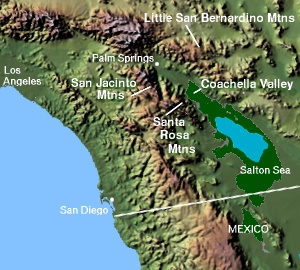Coachella Valley
Coachella Valley is a large valley located in Southern California, in the Colorado Desert region of Riverside County. The valley extends approximately 45 miles (72 km) in a southeast direction from the San Bernardino Mountains to the northern shore of the Salton Sea. It is bounded by the Santa Rosa Mountains to the southwest, the San Jacinto Mountains to the west, and the Little San Bernardino Mountains to the northeast.
Geography[edit | edit source]
The Coachella Valley is part of the larger Sonoran Desert and is characterized by its arid climate, with hot summers and mild winters. The valley floor is largely below sea level, with the lowest point being the Salton Sea, which is 236 feet (72 m) below sea level. The San Andreas Fault runs along the northeastern edge of the valley, contributing to its unique geological features.
History[edit | edit source]
The Coachella Valley has a rich history that dates back thousands of years. It was originally inhabited by the Cahuilla people, who lived in the area for over 2,000 years. The valley was later explored by Spanish explorers in the 18th century and became part of the Mexican California territory. After the Mexican-American War, the valley became part of the United States.
Economy[edit | edit source]
The economy of the Coachella Valley is diverse, with significant contributions from agriculture, tourism, and real estate. The valley is known for its date palm production, and it is one of the largest producers of dates in the United States. Tourism is also a major industry, with attractions such as the Coachella Valley Music and Arts Festival, Palm Springs, and numerous golf courses and resorts.
Climate[edit | edit source]
The Coachella Valley has a desert climate, with extremely hot summers and mild winters. Summer temperatures often exceed 100°F (38°C), while winter temperatures are typically in the 70s°F (20s°C). The valley receives very little rainfall, averaging less than 5 inches (130 mm) per year.
Demographics[edit | edit source]
The Coachella Valley is home to a diverse population, with a mix of permanent residents and seasonal visitors. The largest cities in the valley include Palm Springs, Indio, and Cathedral City. The population is a mix of various ethnic groups, with a significant Hispanic community.
Transportation[edit | edit source]
The Coachella Valley is served by several major highways, including Interstate 10, which runs east-west through the valley. The Palm Springs International Airport provides air travel services, and there are also several smaller regional airports. Public transportation is available through the SunLine Transit Agency.
Education[edit | edit source]
The Coachella Valley is home to several school districts, including the Palm Springs Unified School District, the Desert Sands Unified School District, and the Coachella Valley Unified School District. Higher education institutions in the valley include the College of the Desert and satellite campuses of California State University, San Bernardino and University of California, Riverside.
Related Pages[edit | edit source]
Categories[edit | edit source]
This article is a California location stub. You can help WikiMD by expanding it!
Search WikiMD
Ad.Tired of being Overweight? Try W8MD's NYC physician weight loss.
Semaglutide (Ozempic / Wegovy and Tirzepatide (Mounjaro / Zepbound) available. Call 718 946 5500.
Advertise on WikiMD
|
WikiMD's Wellness Encyclopedia |
| Let Food Be Thy Medicine Medicine Thy Food - Hippocrates |
Translate this page: - East Asian
中文,
日本,
한국어,
South Asian
हिन्दी,
தமிழ்,
తెలుగు,
Urdu,
ಕನ್ನಡ,
Southeast Asian
Indonesian,
Vietnamese,
Thai,
မြန်မာဘာသာ,
বাংলা
European
español,
Deutsch,
français,
Greek,
português do Brasil,
polski,
română,
русский,
Nederlands,
norsk,
svenska,
suomi,
Italian
Middle Eastern & African
عربى,
Turkish,
Persian,
Hebrew,
Afrikaans,
isiZulu,
Kiswahili,
Other
Bulgarian,
Hungarian,
Czech,
Swedish,
മലയാളം,
मराठी,
ਪੰਜਾਬੀ,
ગુજરાતી,
Portuguese,
Ukrainian
Medical Disclaimer: WikiMD is not a substitute for professional medical advice. The information on WikiMD is provided as an information resource only, may be incorrect, outdated or misleading, and is not to be used or relied on for any diagnostic or treatment purposes. Please consult your health care provider before making any healthcare decisions or for guidance about a specific medical condition. WikiMD expressly disclaims responsibility, and shall have no liability, for any damages, loss, injury, or liability whatsoever suffered as a result of your reliance on the information contained in this site. By visiting this site you agree to the foregoing terms and conditions, which may from time to time be changed or supplemented by WikiMD. If you do not agree to the foregoing terms and conditions, you should not enter or use this site. See full disclaimer.
Credits:Most images are courtesy of Wikimedia commons, and templates, categories Wikipedia, licensed under CC BY SA or similar.
Contributors: Prab R. Tumpati, MD

